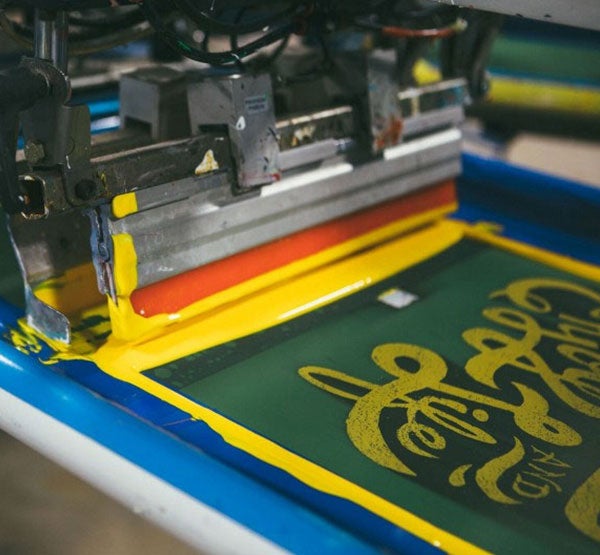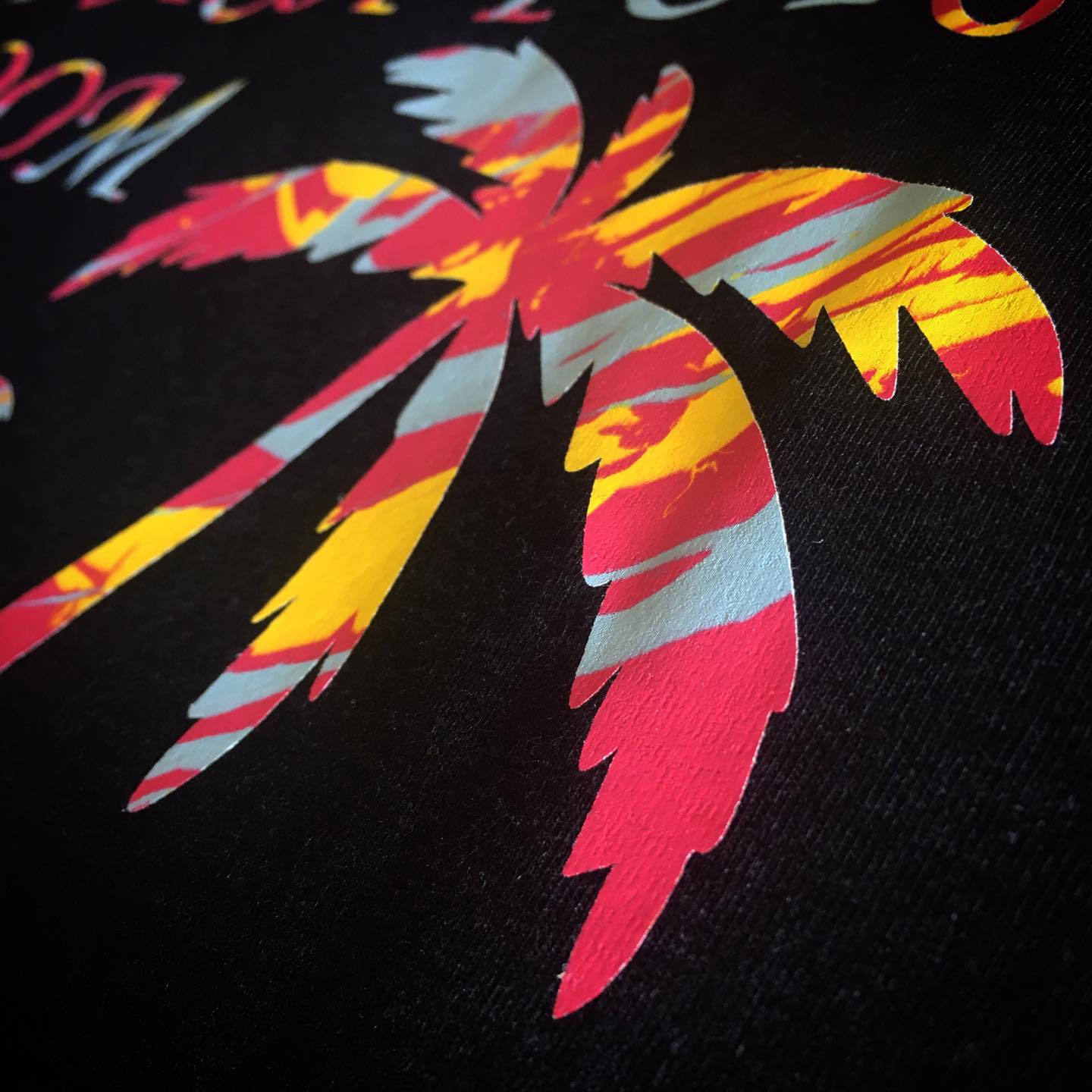Complete Screen Printing Kit for Artists and Creators
Wiki Article
Display Printing Uncovered: Whatever You Need to Find Out About T-Shirt and Garment Printing Methods
Screen printing is an interesting method that integrates art with strategy, supplying countless possibilities for creativity. Prepared to discover the important aspects that make display publishing an art form?
The Essentials of Display Printing: Exactly How It Works
When you plunge into screen printing, you'll uncover it's both a scientific research and an art. At its core, screen printing entails creating a stencil, or screen, that enables ink to pass through just in particular areas.Next, you'll blend your inks and prepare your printing surface area. Placement the screen over the fabric, after that make use of a squeegee to push ink via the display onto the garment. This process requires precision, as you desire clear, dynamic prints. After printing, you'll cure the ink with warmth, ensuring it sticks to the material and lasts with cleans. Each step is vital, and understanding them will elevate your screen printing skills, transforming straightforward garments right into distinct, meaningful pieces.
Sorts Of Display Printing Strategies
Once you grasp the essentials of display printing, it's time to check out the different techniques that can raise your layouts. One preferred technique is standard display printing, where ink is pressed via a stenciled display.One more alternative is plastisol printing, understood for its sturdiness and vivid shades, making it a favorite for many brand names. Experiment with halftone printing to create gradient results and elaborate designs.
Essential Equipment for Display Printing
To achieve spectacular results in screen printing, having the best devices is basic. You'll need a sturdy display printing frame, which holds the mesh that moves your style onto the garment. Next, spend in high-quality squeegees; these are crucial for using ink equally throughout the screen.Picking the Right Inks and Materials
When selecting inks and materials for display printing, you require to take into consideration the kind of ink that functions finest for your job. Assume concerning material compatibility to ensure your styles look last and terrific long. Also, check out eco-friendly ink options to make your printing process more sustainable.Sorts Of Display Inks
Picking the right screen ink is vital for accomplishing lively, resilient prints that fulfill your task's needs. There are a number of kinds of screen inks to check out. Plastisol ink is preferred for its flexibility and simplicity of usage, giving exceptional shade opacity on dark fabrics. Water-based ink, on the various other hand, uses a softer feeling and is environmentally friendly, making it optimal for those wanting to minimize their environmental effect. Discharge inks get rid of dye from the material, causing a soft, classic look however need details handling. Specialty inks, such as metal or glow-in-the-dark, can include unique results to your styles. Examine your task needs and choose the ink that lines up best with your preferred outcome.
Textile Compatibility Considerations
Recognizing textile compatibility is crucial for achieving top quality display prints, especially given that various materials respond uniquely to different inks. Constantly evaluate your inks on example fabric to ensure they adhere appropriately and keep color honesty. Additionally, keep in mind that material weight and texture can impact the last outcome, so choosing the right ink and product combo is crucial for your project's success.Eco-Friendly Ink Options
Eco-friendly inks are coming to be a popular choice for screen printers that wish to minimize their environmental effect while keeping top quality. When selecting inks, think about water-based inks, which are much less harmful and simpler to cleanse up contrasted to traditional solvents. These inks bond well with fabrics, delivering vivid results without hazardous chemicals. You might additionally explore eco-solvent inks that use fewer unstable natural substances (VOCs), making them a much safer alternative for both your health and the planet.Additionally, search for inks made from renewable energies, such as soy or vegetable-based alternatives. By selecting the right inks and materials, you'll not only create spectacular styles however also contribute to an extra lasting printing process. Make the switch, t-shirt printing and your prints will certainly mirror your commitment to the environment!
Preparing Your Layout for Display Printing

Submit Layout Demands
To assure your layout looks dynamic and sharp on material, you'll require to pay close attention to file layout requirements for display printing. Make certain your style has a transparent history to avoid unwanted white edges on your prints. Maintain color modes in mind; CMYK is common for display printing, so convert your RGB makes as necessary.Color Splitting Up Techniques
Color separation is a vital step in preparing your design for screen printing, and mastering it can considerably enhance your print top quality. You'll require to break your design right into specific shades, as each shade needs a different display throughout printing. Beginning by identifying all the shades in your layout and develop layers for each one. You can use software application like Adobe Photoshop or Illustrator to separate and separate colors properly. Be particular to save each layer as a different data, normally in a style like TIFF or PSD. This precision not just guarantees exact color depiction however also streamlines the printing procedure. By focusing on color splitting up, you'll attain professional and dynamic cause your screen-printed garments.Resolution and Dimension
Achieving the ideal results in display printing starts with assuring your style has the best resolution and dimension. Ideally, your artwork needs to be at least 300 DPI (dots per inch) for sharp, clear prints. If you utilize reduced resolution, your last product may look less than professional and pixelated.When it involves dimension, consider the dimensions of your print location. Layout your art work to match the final print size, preferably creating it in the actual measurements you'll be publishing. In this manner, you'll avoid any kind of unexpected scaling concerns.
Always inspect your style in both vector and raster layouts. Vector graphics can be scaled without shedding top quality, making them optimal for display printing. Preparing appropriately will guarantee your style looks impressive on every garment!
Step-by-Step Display Printing Refine
Display printing is a dynamic procedure that allows you to create lively layouts on numerous surfaces. To start, you'll need a display, solution, and your picked ink. Prepare your screen by cleansing it completely. Next, apply the emulsion equally and let it dry in a dark area. As soon as dry, reveal your display to light with your layout put on it, which will certainly solidify the emulsion where the light hits, producing a pattern - screen printing kit.Pour ink onto the display and utilize a squeegee to push the ink via the stencil onto the fabric. Raise the display carefully and let the print dry. You've effectively display printed your layout.
Tips for Effective Screen Printing Projects
While you're diving right into your display printing jobs, keep in mind that preparation is vital to success. Begin by gathering all your materials-- inks, garments, mops, and screens. A clean work space helps stop unwanted errors, so clean prior to you begin.Next, validate your artwork is high-resolution and appropriately sized for your garment. Check your screen for appropriate direct exposure and clean it completely to avoid spots. When blending your inks, adhere to the maker's guidelines to attain the appropriate uniformity.
Throughout printing, apply even stress with your squeegee for regular results. Do not rush; take your time to confirm each print fulfills your standards. After printing, allow your garments dry totally before taking care of or packaging them.
Finally, constantly maintain an example of your benefit future reference. By doing this, you can examine your development and boost your strategies over time. Pleased printing!

Often Asked Concerns
For how long Does It Require To Set up a Screen Printing Job?
Establishing a screen printing job commonly takes around thirty minutes to an hour. You'll prepare the screens, mix inks, and readjust journalism. The moment varies based on complexity and experience, so remain arranged!Can I Print on Various Textile Types Making Use Of the Very Same Strategy?
Yes, you can publish on different material types using the same strategy, yet you'll require to adjust your inks and settings. Some fabrics take in ink in different ways, so exploring warranties the most effective outcomes for every material.What Prevail Blunders to Avoid in Display Printing?
When screen printing, stay clear of common mistakes like using the incorrect ink, neglecting correct direct exposure times, or missing pre-press checks. Always check your setup and maintain tidy displays to assure high quality outcomes each time.Exactly How Can I Effectively Clean and Keep My Screen Printing Tools?
To correctly tidy and maintain your display printing equipment, you need to frequently wash displays with suitable solvents, check mops for wear, and guarantee all tools are kept dry and dust-free. Consistency boosts and prevents expensive repair services performance.Is Screen Printing Eco-friendly Compared to Other Techniques?
Display printing can be more eco friendly than other approaches, particularly if you use eco-conscious products and water-based inks. By choosing lasting supplies and practices, you decrease waste and reduce your effect on the planet.Display Printing Uncovered: Every Little Thing You Need to Know Concerning Tee Shirt and Garment Printing Strategies
At its core, screen printing entails producing a pattern, or screen, that enables ink to pass with only in certain areas. Setting the screen over the fabric, after that make use of a squeegee to press ink through the display onto the garment. One popular technique is standard screen printing, where ink is pushed via a stenciled display.When picking inks and materials for display printing, you require to take right into account the kind of ink that works best for your project.
Report this wiki page